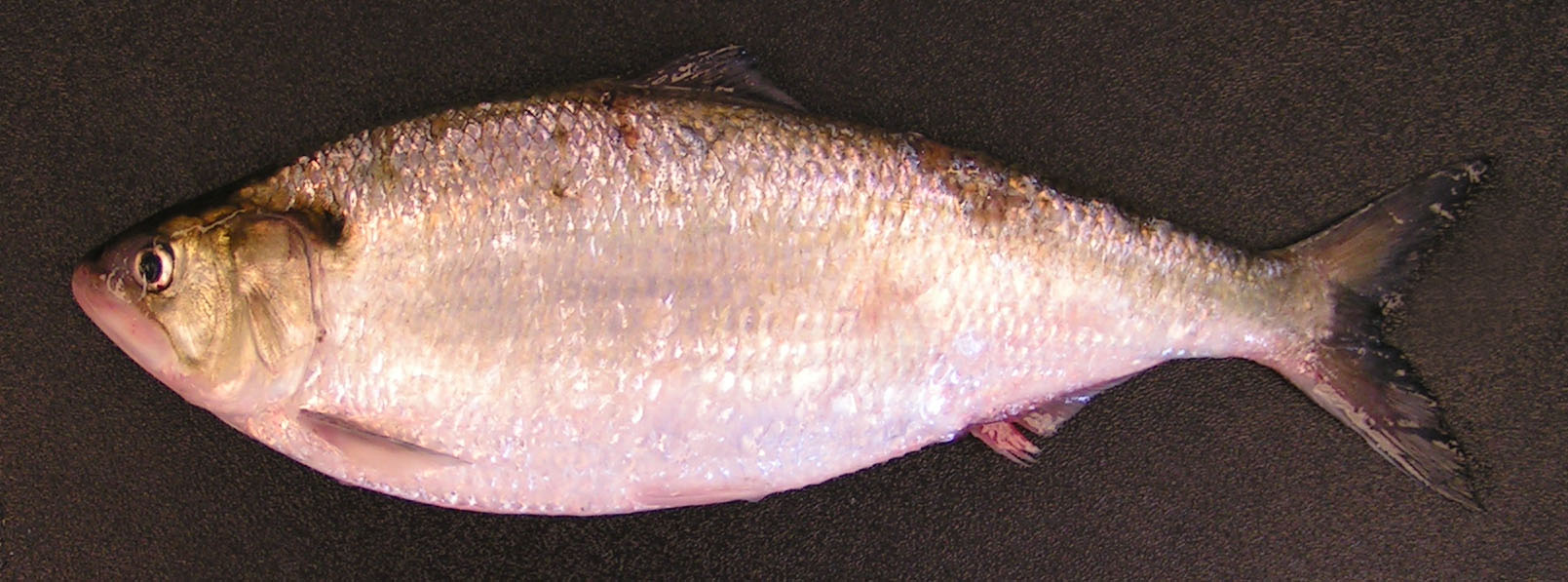American shad
Life History
 American shad are anadromous, meaning they live in saltwater but spawn in freshwater. They are found along the Atlantic coast from the St. Lawrence River, Canada to St. John's River, Florida. American shad were introduced to the Pacific coast in the late 1800s and are now found from Cook Inlet, Alaska to Baja California in Mexico. They are a highly migratory species that spend most of their adult life in large schools. Every spring sexually mature American shad return to their natal river to spawn. The spawning migration is related to latitude and temperature, southern stocks beginning their run before the northern stocks. In Virginia the spawning run begins in late February and continues through June, with peak spawning occurring when water temperatures are between 8 and 20°C.
American shad are anadromous, meaning they live in saltwater but spawn in freshwater. They are found along the Atlantic coast from the St. Lawrence River, Canada to St. John's River, Florida. American shad were introduced to the Pacific coast in the late 1800s and are now found from Cook Inlet, Alaska to Baja California in Mexico. They are a highly migratory species that spend most of their adult life in large schools. Every spring sexually mature American shad return to their natal river to spawn. The spawning migration is related to latitude and temperature, southern stocks beginning their run before the northern stocks. In Virginia the spawning run begins in late February and continues through June, with peak spawning occurring when water temperatures are between 8 and 20°C.
American shad spawn in tidal and non-tidal freshwater zones. Males arrive at the spawning sites first followed by the females. Areas with high water velocity and dissolved oxygen levels are prime spawning locations. Shad prefer depths of less then 4 meters with silt, gravel, or sandy bottoms. Spawning generally occurs overnight beginning at dusk. Females are batch spawners, releasing eggs every 2-3 days during the spawning season. Adult females can release up to 600,000 eggs per season. Surrounding males release their milt fertilizing the eggs. The fertilized eggs drift down river and hatch within 4 to 12 days.
 After hatching the larvae will feed on their yolk sac for 4-7 days before finding food. They are very susceptible to starvation and predation during this period. Larvae turn into juveniles 3-5 weeks after hatching and are roughly 28mm in length. Juveniles feed on plankton; mostly copepods, amphipods, mysid shrimp, and insect larvae. Juveniles fall prey to many species including striped bass, bluefish, weakfish, and eels. As the juvenile shad grow they move downstream. Peak downstream migration occurs in late October-November. Juveniles will remain in freshwater until the fall when they form schools and migrate to open waters. Some juveniles will spend their first year in estuaries or nearshore waters. Shad will not return to freshwater until they reach sexual maturity, between 3-7 years.
After hatching the larvae will feed on their yolk sac for 4-7 days before finding food. They are very susceptible to starvation and predation during this period. Larvae turn into juveniles 3-5 weeks after hatching and are roughly 28mm in length. Juveniles feed on plankton; mostly copepods, amphipods, mysid shrimp, and insect larvae. Juveniles fall prey to many species including striped bass, bluefish, weakfish, and eels. As the juvenile shad grow they move downstream. Peak downstream migration occurs in late October-November. Juveniles will remain in freshwater until the fall when they form schools and migrate to open waters. Some juveniles will spend their first year in estuaries or nearshore waters. Shad will not return to freshwater until they reach sexual maturity, between 3-7 years.
After spawning American shad will die or return to sea. They begin their migration to the Gulf of Maine for summer feeding. Active feeding takes place during summer and fall months. Adults feed on plankton, small crustaceans, and fish. American shad have a number of predators such as sharks, tunas, striped bass, mackerel, marine mammals, and seabirds. American shad overwinter in deep waters offshore. During the winter, feeding decreases and shad experience a period of slow growth. Beginning in late winter and early spring the cycle continues as shad begin the spawning migration.
